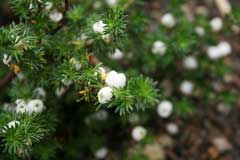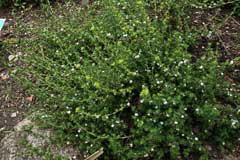 |
|
http://commons.wikimedia.org/wiki/User:Sten |
 |
| http://commons.wikimedia.org/wiki/User:Sten |
Translate this page:
Summary
Physical Characteristics

 Margyricarpus pinnatus is an evergreen Shrub growing to 0.3 m (1ft) by 1 m (3ft 3in) at a medium rate.
Margyricarpus pinnatus is an evergreen Shrub growing to 0.3 m (1ft) by 1 m (3ft 3in) at a medium rate.
See above for USDA hardiness. It is hardy to UK zone 9 and is not frost tender. It is in leaf all year, in flower from July to August, and the seeds ripen from August to September. The species is hermaphrodite (has both male and female organs) and is pollinated by Insects.
Suitable for: light (sandy), medium (loamy) and heavy (clay) soils, prefers well-drained soil and can grow in nutritionally poor soil. Suitable pH: mildly acid and neutral soils. It can grow in semi-shade (light woodland) or no shade. It prefers moist soil. The plant can tolerates strong winds but not maritime exposure.
UK Hardiness Map
US Hardiness Map
Synonyms
M. setosus. Empetrum pinnatum.
Plant Habitats
Woodland Garden Sunny Edge; Dappled Shade; Cultivated Beds;
Edible Uses
Edible Parts: Fruit
Edible Uses:
Fruit - raw or cooked[2, 105]. Pleasant but mild with a slightly acid flavour[11, 183]. The fruit can hang on the plant for a long time in good condition if it is not eaten by birds etc[1]. The fruit is a small white berry about 7mm in diameter with a single seed[200]. Very attractive to look at, but the flavour is very mild and you need to spend quite a while picking just to get one mouthful[K]. Children really love the fuit, however, and this makes it an ideal plant to get them out of your hair for a while. Simply tell them that they can have as much of the fruit as they want and they will be there for half an hour or more picking it[K].
References More on Edible Uses
Medicinal Uses
Plants For A Future can not take any responsibility for any adverse effects from the use of plants. Always seek advice from a professional before using a plant medicinally.
Diuretic
Diuretic[46, 61].
References More on Medicinal Uses
The Bookshop: Edible Plant Books
Our Latest books on Perennial Plants For Food Forests and Permaculture Gardens in paperback or digital formats.

Edible Tropical Plants
Food Forest Plants for Hotter Conditions: 250+ Plants For Tropical Food Forests & Permaculture Gardens.
More

Edible Temperate Plants
Plants for Your Food Forest: 500 Plants for Temperate Food Forests & Permaculture Gardens.
More

More Books
PFAF have eight books available in paperback and digital formats. Browse the shop for more information.
Shop Now
Other Uses
References More on Other Uses
Cultivation details
Prefers a lime-free soil that is not too rich[11], with some shade at the hottest part of the day[200]. Requires a sunny position and a well-drained soil[11]. Requires a sheltered position[188]. Plants are low-growing and have done very well in our exposed maritime site in Cornwall[K]. This species is hardy to about -5°c[200]. It is our opinion that the plants are hardier than this[K], they have grown outdoors in many parts of Britain that experience colder winters, and have survived all but very severe winters[1, 11]. The plants do not fruit well in cool wet summers[K].
References Carbon Farming Information and Carbon Sequestration Information
Temperature Converter
Type a value in the Celsius field to convert the value to Fahrenheit:
Fahrenheit:
The PFAF Bookshop
Plants For A Future have a number of books available in paperback and digital form. Book titles include Edible Plants, Edible Perennials, Edible Trees,Edible Shrubs, Woodland Gardening, and Temperate Food Forest Plants. Our new book is Food Forest Plants For Hotter Conditions (Tropical and Sub-Tropical).
Shop Now
Plant Propagation
Seed - sow late winter or early spring in a greenhouse[78]. The seed can be rather slow to germinate and probably needs a short period of cold stratification[K]. Prick out the seedlings into individual pots when they are large enough to handle and grow them on in the greenhouse for their first winter. When the plants are large enough, plant them out in late spring or early summer and consider giving them some protection from the cold for their first winter outdoors[K]. Cuttings of half-ripe wood, 4 - 5 cm with a heel, July/August in a frame[78]. Layering[200].
Other Names
If available other names are mentioned here
Native Range
SOUTHERN AMERICA: Brazil (Mato Grosso do Sul, Paraná, Rio Grande do Sul, Santa Catarina), Bolivia, Ecuador, Peru, Argentina (Córdoba, Mendoza, Buenos Aires, Chubut, Entre Ríos, La Pampa, Neuquén, Río Negro, Salta, Santa Cruz, Tucumán), Chile, Uruguay
Weed Potential
Right plant wrong place. We are currently updating this section.
Please note that a plant may be invasive in one area but may not in your area so it's worth checking.
Conservation Status
IUCN Red List of Threatened Plants Status :

Growth: S = slow M = medium F = fast. Soil: L = light (sandy) M = medium H = heavy (clay). pH: A = acid N = neutral B = basic (alkaline). Shade: F = full shade S = semi-shade N = no shade. Moisture: D = dry M = Moist We = wet Wa = water.
Now available:
Food Forest Plants for Mediterranean Conditions
350+ Perennial Plants For Mediterranean and Drier Food Forests and Permaculture Gardens.
[Paperback and eBook]
This is the third in Plants For A Future's series of plant guides for food forests tailored to
specific climate zones. Following volumes on temperate and tropical ecosystems, this book focuses
on species suited to Mediterranean conditions—regions with hot, dry summers and cool, wet winters,
often facing the added challenge of climate change.
Read More
Expert comment
Author
(Lam.)Kuntze.
Botanical References
11200
Links / References
For a list of references used on this page please go here
Readers comment
| Add a comment |
|
If you have important information about this plant that may help other users please add a comment or link below. Only comments or links that are felt to be directly relevant to a plant will be included. If you think a comment/link or information contained on this page is inaccurate or misleading we would welcome your feedback at [email protected]. If you have questions about a plant please use the Forum on this website as we do not have the resources to answer questions ourselves.
* Please note: the comments by website users are not necessarily those held by PFAF and may give misleading or inaccurate information.
To leave a comment please Register or login here All comments need to be approved so will not appear immediately.
|
Subject : Margyricarpus pinnatus
|
|
|
|